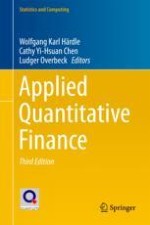2017 | OriginalPaper | Chapter
14. Measuring and Modeling Risk Using High-Frequency Data
Authors : Wolfgang Karl Härdle, N. Hautsch, U. Pigorsch
Published in: Applied Quantitative Finance
Publisher: Springer Berlin Heidelberg
Activate our intelligent search to find suitable subject content or patents.
Select sections of text to find matching patents with Artificial Intelligence. powered by
Select sections of text to find additional relevant content using AI-assisted search. powered by
